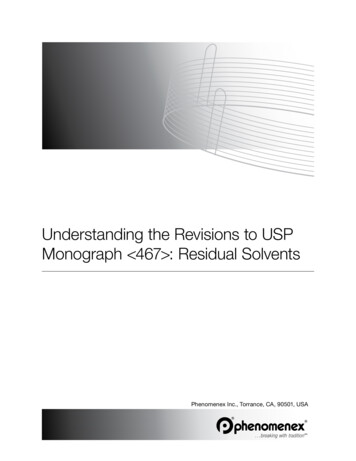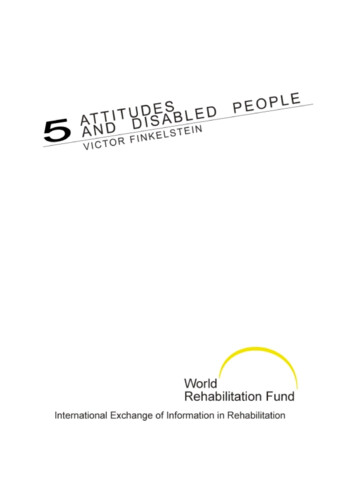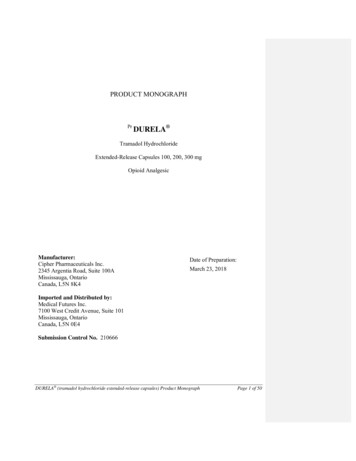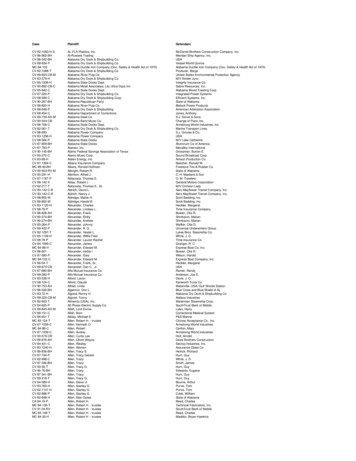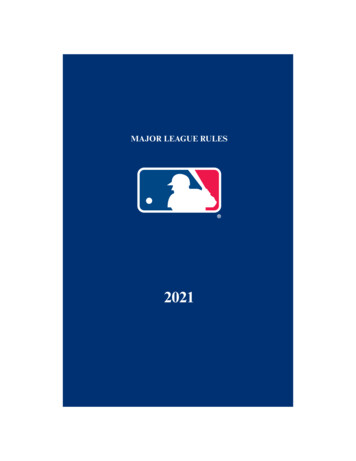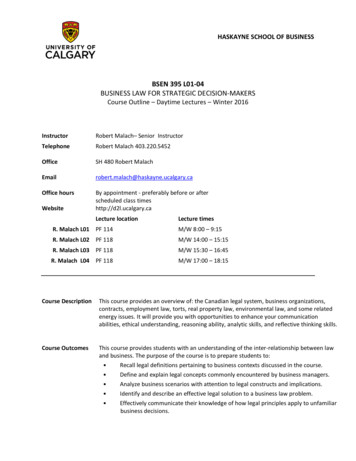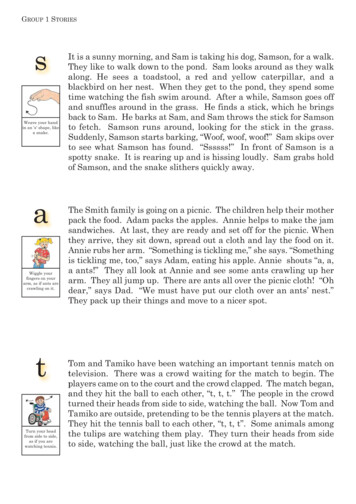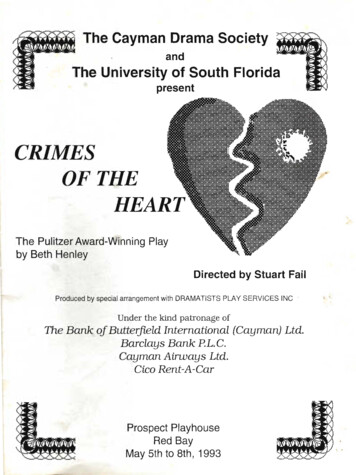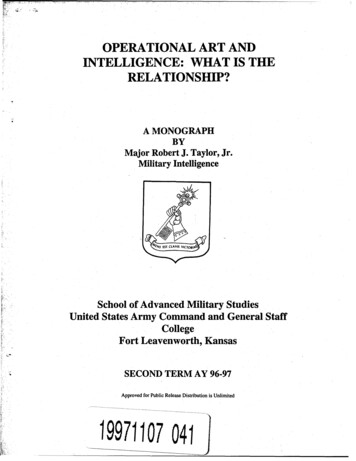
Transcription
OPERATIONAL ART ANDINTELLIGENCE: WHAT IS THERELATIONSHIP?A MONOGRAPHBYMajor Robert J. Taylor, Jr.Military IntelligenceSchool of Advanced Military StudiesUnited States Army Command and General StaffCollegeFort Leavenworth, KansasSECOND TERM AY 96-97Approved for Public Release Distribution is Unlimited19971107 041
SREPORT DOCUMENTATION PAGEForm ApprovedOMB No. 0704-0188Public reporting burden for this collection of information is estimated to average 1 hour per response, including the time for reviewing instructions, searching existing data sources,gathering and maintaininn the data needed, and completing and reviewing the collection of information. Send comments regarding this burden estimate or any other aspect of thiscollection of information, including suggestions for reducing this burden, to Washington Headquarters Services, Directorate for Infomation Operations and Reports, 1215 JeffersonDavis Highway, Suite 1204, Arlington, VA 22202-4302, and to the Office of Management and Budget, Paperwork Reduction Project (0704-0188), Washington, DO 20503.1. AGENCY USE ONLY (Leave blank)2. REPORT DATEŽZ;),A3. REPORT TYPE AND DATES COVEREDIq q-MONOGRAPH4. TITLE AND SUBTITLE5. FUNDING NUMBERSAIs -r )""T,,zLcN2Z-uYV /41n,6. AUTHOR(S)7. PERFORMING ORGANIZATION NAME(S) AND ADDRESS(ES)8. PERFORMING ORGANIZATIONSchool of Advanced Military StudiesREPORT NUMBERCommand and General Staff CollegeFort Leavenworth, Kansas 660279. SPONSORING / MONITORING AGENCY NAME(S) AND ADDRESS(ES)10. SPONSORING / MONITORINGAGENCY REPORT NUMBERCommand and General Staff CollegeFort Leavenworth, Kansas 6602711. SUPPLEMENTARY NOTES12a. DISTRIBUTION /AVAILABILITY STATEMENT12b. DISTRIBUTION CODE13. ABSTRACT (Maximum 200 words)SEE ATTACHED14. SUBJECT TERMSwPot3,15. NUMBER OF PAGEST,-zfyq --4ppe- tOPL--4TtoA L17. SECURITY CLASSIFICATIONOF REPORT18. SECURITY CLASSIFICATIONOF THIS PAGEUNCLASSIFIEDUNCLASSIFIEDNSN 7540-01-280-5500--16. PRICE CODE19. SECURITY CLASSIFICATION 20. LIMITATION OF ABSTRACTOF ABSTRACTUNCLASSIFIEDUNLIMITEDStandard298 (Rev.2-89) 298-102PrescribedFormby ANSIStd. Z39-18USAPPC V1.00
SCHOOL OF ADVANCED MILITARY STUDIESMONOGRAPH APPROVALMajor Robert J.Title of Monograph:Jr.Taylor,Operational Art and Intelligence:isWhatthe Relationship?Approved by:OL arE. Phillips,JMavis,COLDDannyMA, MMASMonograph DirectorDirector, School ofAdvanced MilitaryStudiesGraduateDirector,Philip J.Brookes,Ph.D.Degree ProgramAccepted this 22d Day of May 1997
ABSTRACTOperational Art and Intelligence: What is the Relationship? by MAJ Robert J. Taylor Jr.,USA, 59 pages.This monograph discusses the role of intelligence in support of operational art.Intelligence support at all levels of war is critical for the commander to successfully applyforce to achieve the established goals and objectives. This is particularly true at theoperational level where the operational commander must translate strategic objectives intotactical actions. This monograph examines the characteristics and nature of intelligencesupport to the operational artist.The monograph first determines the definition of intelligence and its principles andcharacteristics. Intelligence is defined as information or knowledge of the enemy andenvironment, both of which are packaged for a specific customer's use in decision making.Furthermore, the principles of intelligence are based on the component parts ofknowledge, otherwise identified as the verb know. The principles are detect, recognize,and understand, representing levels of perception higher than the previous. Finally, thecharacteristics of intelligence are identified as relevant, timely, accurate, and predictive.Since operational art is rooted in theory, the monograph then briefly discusses thetheoretical basis of the terms center of gravity, decisive point, and indirect approach fromthe standpoint of Carl Von Clausewitz, Antoine Henri Jomini, and Sun Tzu respectively.These concepts provide the basis to discuss operational art, or maneuver warfare.The monograph defines operational art as the conduct of military activities at theoperational level through the translation of strategic objectives into tactical actions. Moreimportantly, the tasks of the operational artist are defined. These tasks are know, plan andexecute, and are the basis for intelligence support to the operational artist. Withoutadequate intelligence, the accomplishment of these tasks would at best be difficult andlikely to be costly in blood and treasure.Operational art requires an extensive intelligence effort. Intelligence at theoperational level is defined as information or knowledge of the enemy and environmentrequired by the operational commander to make decisions and to plan and executecampaigns and major operations. The theoretical foundation of operational art providesthe same basis for operational intelligence, to determine centers of gravity and theircomponent decisive points as tactical objectives that linked together identify the indirectapproach leading to the achievement of the operational and strategic endstate.Finally, the monograph examines Army and Joint doctrine. It determines that bothdoctrines adequately describe operational intelligence characteristics and the importance ofintelligence to operational success. However, both similarly fail to adequately identify thelinkage between operational art and intelligence, particularly concerning military objectivesand operational design through the theoretical concepts of center(s) of gravity, decisivepoints, and the indirect approach.
V
Operational Art and Intelligence:What is the Relationship?A MonographByMajor Robert J. Taylor, Jr.Military IntelligenceSchool of Advanced Military StudiesArmy Command and General Staff CollegeStatesUnitedFort Leavenworth, KansasSecond Term AY 96-97Approved for Public Release: Distribution is Unlimited
TABLE OF CONTENTSI. Introduction .2II. What is Intelligence? .7III. Theoretical Background .12IV . Operational Art .22V. Defining Operational Intelligence .32VI. Doctrinal Assessment .42VII. C o n clu sio n .47En d n o te s .51B ib liog ra p hy .55
Section I-IntroductionA commander who boldly determines - without knowledge ofthe enemy or the battleground - to close with the foe and destroy himwherever he might be, is like a boxer who is in the ring blindfolded.'As the world changes so will the character of war, and it will require continuedstudy by both military and political leaders to ensure they are aware of the potential risksof using military force to achieve political objectives. An essential element ofunderstanding war is the thoughtful awareness of the environment and adversary, orintelligence. The study of intelligence at a particular level of war first requires anunderstanding of the currently accepted framework of conflict. Likewise, to study anyone perspective of war, one must initially consider the whole of war before itscomponents.2 Whether one is studying, planning or conducting war, it can be viewedfrom three perspectives, each of which provides a unique picture to the viewer. However,there are no distinct lines separating the perspectives. Awareness that they overlap iscritical to the clear understanding of each level. The three perspectives, or levels, arestrategy, operations, and tactics.Starting at the top, the strategic perspective of war provides a view of the nation atwar, using its capabilities in coordination to attain national goals by use of force.3 For ourpurposes, strategy can be divided into two areas, national strategy and military strategy.National strategic considerations concern the national command authority. Ralph Allendescribed national strategy as the 'art of the civilian.' 4 Military strategy then becomes theart of generals, where the President is the Commander in Chief (CINC), exercising civiliancontrol of the military as one aspect of national strategy. At the strategic level, military art2
is prevalent. TRADOC PAMPHLET 11-9, Blueprint of the Battlefield, defines thestrategic level of war as:.the level of war at which a nation or group of nations determinesnational or alliance security objectives and develops and uses nationalresources to accomplish those objectives. Activities at this level establishnational and alliance military objectives; sequence initiatives; define limitsand assess risks for the use of military and other instruments of power;develop global or theater war plans to achieve those objectives; and, providearmed forces and other capabilities in accordance with the strategic plan .With this as the footing, strategic level objectives are used as the foundation forestablishing objectives and assigning missions at lower levels, operational and tactical.Strategic guidance begins the vertical linkage of objectives at each level of war.At the other end of the spectrum is the tactical perspective. At this levelcommanders concern themselves with purely military objectives. Typically, tacticalcommanders destroy enemy forces, seize specific terrain or otherwise apply military forceto accomplish the missions prescribed by the operational level. 6 At the tactical level,military science is dominant over military art. Tactical success may simply equate toaccomplishing military tasks such as seizing terrain and destroying forces. Again, theBlueprint provides the best definition:Tactical level of war is the level of war at which battles andengagements are planned and executed to accomplish military objectivesassigned to tactical units or task forces. Activities at this level focus onthe ordered arrangement and maneuver of combat elements in relation toeach other and to the enemy to achieve combat objectives .The departure from the quest for the single decisive battle to the maneuver ofdivisions and corps across a theater of operations spawned the origin of the operationallevel of war, the focus of this study.'This level includes the employment of land, sea, and3
air forces that concentrate on attaining strategic objectives. 9 Defined in the Blueprint, thisis the level where tactical action is linked to strategic aims:Operational level of war is the level of war at which campaignsand major operations are planned, conducted, and sustained to accomplishstrategic objectives within theaters or areas of operations. Activities atthis level link tactics and strategy by establishing operational objectives,needed to accomplish the strategic objectives, sequencing events to achieveoperational objectives, initiating action, and applying resources to bringabout and sustain those events. These activities imply a broader dimensionof time or space than do tactics, they ensure the logistic and administrativesupport of tactical forces, and provide the means by which tactical successesare exploited to achieve strategic objectives. 0The operational level of war then is the essential link between the desired endstatedetermined at the strategic level and the chaos of war conducted at the tactical level.Operational art "orders" tactical combat. Furthermore, it is at this level where military artand science are evenly applied. As such, the operational perspective may be the mostcritical to understand, ensuring that national blood and treasure are not expended intactical battles that fail to lead to the attainment of the strategic goals. Clayton Newellstates, "In a general sense, tactical level commanders fight; operational level commandersdefine where and how to fight, and strategic commanders decide whether or not tofight.'uiUnderstanding the levels of war provides a framework for where the operationallevel fits. It also provides the foundation to begin the study of operational art.Conducting military activities at the operational level, in its most simple sense, isoperational art. There is much more to it, but the translation of strategic objectives into acampaign with attainable tactical objectives for available military forces is the underlyingcore of operational art.124
Operational art can be considered synonymous with maneuver warfare.According to Professor James J. Schneider, its evolution occurred at the time of theAmerican Civil War.13 He explains that previous to this time, the classical strategy of thedecisive battle of annihilation was the preferred method. The purpose of maneuver inclassical strategy was to achieve maximum concentration through decisive positionaladvantage at the outset of battle in order to destroy the enemy's army. Technologicalinnovations such as the rifled musket, railroad, telegraph, and the industrial revolutionallowing mass production led to the emergence of dispersion on the battlefield anddistributed maneuver. Such innovations drove changes in organization, and command andcontrol leading to operational art. Operational art transformed classical strategy intooperations distributed in depth across the battlefield where maneuver maximizes freedomof action and destroys the enemy's capacity to wage war.14Operational art, or maneuver warfare, is highly dependent on knowledge of theenemy. For the commander, operational art represents a way of thinking that transcendsthe tactical level and focuses his attention on the contribution of his plans and actions onthe battlefield to the overall strategic objectives of war. The essential element toaccomplish this is understanding the enemy. Operational art avoids the classical strategyof head on collisions with major enemy forces. The operational artist seeks to maneuverdispersed, swarm faster than the enemy to create combat power, apply combat power atthe decisive point and time against an enemy weakness, then quickly disperse to preparefor the next opportunity. 15 Thus, the application of operational art is highly dependent onintelligence.5
Waging war without intelligence is possible, but may be better described asexpensive, dangerous and aimless destruction. Conversely, warfare waged with excellentintelligence increases the chances of success exponentially. In this respect, intelligenceplays a supportive role, yet supportive is not synonymous with secondary or unimportant.Arguably, intelligence is the most critical support function. It provides, at least in part, arationale for the employment of major forces by reducing uncertainty in the mind of thecommander. Furthermore, critical to the success of any major operation, or campaign, isan intelligence system that provides timely, accurate, and relevant intelligence to theoperational commander and subordinate units. This monograph examines the nature andcharacter of operational intelligence and the manner in which it supports operational art.Further, it determines if operational intelligence is adequately addressed in doctrine tosupport operational art.The method for this examination is simple. The first task is to adequately defineintelligence. In addition to the definition, the characteristics and principles of intelligencewill be identified and provide the foundation to examine intelligence at the operationallevel of war. The second task is to provide the reader with a solid theoretical foundation.A review of Sun Tzu, Clausewitz, and Jomini from an intelligence perspective providesinsight into the basis for intelligence as it applies to operational art. The third taskinvolves the examination of operational art in order to determine tasks of the operationalartist. These tasks then ascertain the requirements of operational intelligence to supportthe operational commander. This examination determines the intelligence demands ofoperational art. The fourth task is to deduce a clear definition of operational intelligence6
and the imperatives of intelligence support to the operational artist. Finally, Joint andArmy doctrine will be analyzed to determine if intelligence is appropriately addressed tosupport the operational commander.Section 2-What is Intelligence?So important is information in war that the first paragraph of anyoperation order or the first part of any oral instructions is devoted to"information of the enemy.,16The definitions of intelligence are many and varied. It can be defined by the typeof product used to package it, such as an intelligence briefing or estimate. A systemsapproach defines intelligence as a series of actions, such as collection, processing, analysis,and finally a product. Intelligence has also been used to pigeonhole organizations withinthe government, such as "intelligence community." Intelligence can also be categorized byhow it is used or gathered, such as scientific intelligence or human intelligence,respectively. 17 Regardless of its many definitions, intelligence is information about someone, something, some place, or some activity that was previously unknown.Joint Pub 1-02, Department of Defense Dictionary of Military and AssociatedTerms, has two entries for the definition of intelligence. The first states it is "the productresulting from the collection, processing, integration, analysis, evaluation, andinterpretation of available information concerning foreign countries or areas." The secondentry states that intelligence is "information and knowledge about an adversary obtainedthrough observation, investigation, analysis, or understanding.The first entry identifiesintelligence as a product resulting from a systematic process, while the second relates to7
information or knowledge. Both definitions are somewhat vague, and leave room forinterpretation.The Army uses the Joint definition of intelligence. As such, it categorizesintelligence based on the corresponding levels of war; strategic, operational, and tactical.The levels of intelligence are explicit to military intelligence, intelligence specificallyconcerned with military capabilities of foreign countries, or topics affecting potential USor allied military operations relating to numerous areas. 19 Accordingly, the definition ofeach level tends to illustrate the term "support," followed by a definition of that level ofwar. 20 The concept of levels of intelligence is of use, but a clear definition of intelligenceis imperative to grasp the full significance of it to a decision maker.Defining intelligence is not a new problem. The 1955 Hoover Commission's TaskForce on Intelligence Activities sought "an acceptable definition of intelligence," butlearned that each government agency had its own definition to fit their own purposes.They found that many definitions were "lengthy" and "required additional interpretation ordelimitation to get at their precise application." What they sought was a definition "assimple and clear as possible," which is exactly what a definition should be.z2 Since then,the definition of intelligence has not been narrowed. The 1990 dictionary of intelligenceterms highlights this point with 17 pages and 127 entries for the word, intelligence.22The point of this discussion is to highlight the variety of interpretations forintelligence. For this paper, intelligence is defined as the information or knowledge of theenemy and the environment, both of which are processed and packaged for a specificcustomer's use in decision making.23 This study is not the first to consider this angle on8
intelligence. LTC Robert Glass, author of Intelligence Is For Commanders, grasped thevalue of intelligence for decision makers as early as 1948. He states, "To a competentcommander, sound and accurate intelligence is a weapon - a supporting 'arm'. Whenproperly understood by a commander, and confidently used, it increases his capabilities for24success at all levels.",The first part of the definition identifies the task of intelligence, which is to provideinformation, or knowledge, of the enemy and environment. Joint Pub 2-0, Joint Doctrinefor Intelligence Support to Operations, defines information as "unprocessed data of everydescription which may be used in the production of intelligence.", 25 However, information26is more than "any scrap of gossip, or rumor, but relevant information" (my emphasis).Intelligence is specific information that the decision maker needs. In this sense, enemyactivities are only significant in relation to what one's own forces are doing or areplanning to do. Unfortunately, isolated information not taken in context with friendlyforces and other pieces of information remain insignificant facts. In intelligence work,such facts do not speak for themselves. Facts, or information, require analysis andinterpretation.Furthermore, the precise intelligence a commander requires will not normally beeasy to acquire. The enemy continually attempts to hide information regarding his forcesand plans in order to conceal his intent. With this in mind, there will almost always besome information available regarding the opponent, but rarely will every piece of theinformation puzzle be known. In most cases some facts will be known, pieced togetherfrom all kinds of sources, including factual reports, rumors and opinions. Intelligence9
then, is a matter of piecing together many different pieces of information to provide ananswer.27 The collation of many pieces determines the completeness of intelligence.Within this context, any one piece of information remains accurate for only a certainperiod of time. During the time required to execute the intelligence process, some ofthese pieces cease to be accurate. 28 Because all pieces of information may not be readilyavailable, or some portions outdated and inaccurate, effective intelligence requiresinterpretation. The analyst managing the intelligence effort requires certain vision, similarto operational art, combining science (facts) with art (interpretation). The success ofintelligence in the first part of the definition of intelligence depends on available raw data,identified as facts, and the accurate perception of the collated facts.29The second part of the definition is the most important, and specifically deals withthe purpose of intelligence. The purpose being to help the commander make a decisionand thereby proceed more accurately and confidently with the accomplishment of themission.30 Furthermore, the ultimate objective of intelligence is to enable the decisionmaker to choose the optimal action. The individual which has to decide on action needsinformation about his opponent, information likely to be vital in prompting decisions. Thisvital information may suggest that action should be taken on a scale larger or smaller thanoriginally planned, or even that a completely different course of action would be better topursue.31With this in mind, how does information aid the leader in making decisions? Inwarfare, ambiguous situations tend to be the rule. In many cases, there are severe gaps inavailable intelligence holdings. These gaps generate uncertainty in the mind of a leader10
regarding pending actions. A leader's uncertainty typically entails lack of knowledgeconcerning a particular aspect of the environment or the threat that is critical to attain aspecific end. Relevant information aids the decision maker by answering particularquestions. Timely, accurate intelligence, properly applied can significantly reduceuncertainty, but rarely can intelligence eliminate it entirely. Reducing uncertainty enablesleaders to improve the timelines and quality of their decisions, develop more effectiveplans, and ultimately conduct more successful operations.32Knowing and understanding the definition of intelligence may not be enough toproceed. The principles and characteristics of intelligence also need clarification.Principles are determined from the requirement to know the adversary and theenvironment. If intelligence is knowledge, or knowing, principles are the component partof know. From the perspective of knowing, expressed as a verb, the principles provide abasic understanding of what must be done, rather than as nouns, focused on products orproducers, such as imagery or unmanned aerial vehicles. Furthermore, verbs allow thosewho use the principles to realize that there are many ways to accomplish what must bedone, utilizing many different sources, and generating many different products to fill theleaders information requirement. The principles of intelligence are derivatives of know,and identified as the verbs detect, recognize, and understand. They represent levels ofperception arranged in order of hierarchial discernment. For example, it is much easier todetect than to understand. 3These principles are closely tied to the characteristics of intelligence.Characteristics originate from the specific requirement of a leader for information11
according to the principles previously identified. Characteristics describe the information34provided to facilitate the decision. They are; relevant, timely, accurate, and predictive.Relevant intelligence answers the decision maker's uncertainty questions. Timelyintelligence arrives allowing sufficient time to implement the decision (action or reaction).Accurate intelligence correctly represents the information to the leader. Finally, predictiveintelligence anticipates enemy actions or reactions, and future needs of the leader.This section was titled, "What is intelligence?" That question has been answered.It is defined as information or knowledge of the enemy and the environment, both ofwhich are processed and packaged for a specific customer's requirement for makingdecisions. Furthermore, intelligence is specific information that reduces uncertainty in themind of a leader, allowing more timely implementation of decisions, thereby increasing thechances of successful actions. It's principles are identified as components of knowing, andare the action verbs detect, recognize, and understand. Each principle represents a level ofperception higher than the previous. Finally, the characteristics of intelligence describe theinformation, regardless of the principles, facilitating leader's decisions. The characteristicsare relevant, timely, accurate, and predictive.Section 3-Theoretical BackgroundThe primary purpose of any theory is to clarify concepts andideas that have become, as it were, confused and entangled. Not untilterms and concepts have been defined can one hope to make any progressin examining the question clearly and simply and expect the reader toshare one's views.3512
Carl Von Clausewitz, Sun Tzu and Antoine Henri Jomini are three of the mostinfluential theorists currently read. However, they are far from the only ones to influenceUS Army doctrine. Furthermore, full discussion of any one of the three requires muchmore space than one section of a monograph, much less attempting to analyze all three.Nonetheless, a short audit of each of their contributions and views furnishes a solidfoundation to complete a study of intelligence support to operational art.A review of these three military theorists provides two things for the study of theoperational level of war. First and foremost is examination of each theorist's mostsignificant conceptual theoretical contribution. Second is analysis of their theoreticalviews of intelligence, its capabilities and influence in war. Finally, their views arecompared to provide a theoretical baseline of intelligence support to warfighters.Arguably, the most significant contribution of Clausewitz is his concept of thecenter of gravity. This concept may also be the least well understood. Instead ofpunishing ourselves with disagreement of what Clausewitz really meant by center ofgravity, we can better analyze what it can mean to the military professional. Clausewitzintended it to be an analogy and heuristic device to provide focus and unity of effort forthe application of military force. 6 Addressing the center of gravity, Clausewitz states,One must keep the dominant characteristics of both belligerentsin mind. Out of these characteristics a certain center of gravity develops,the hub of all power and movement, on which everything depends. Thatis the point against which all our energies should be directed.7The significance of this concept is its linkage with strategic and operational aims orobjectives of war. Two principles standout concerning such a linkage. Centers of gravityare derived from the aims at the level of war you are planning for, and objectives13
established at the operational and tactical levels of war aid in imposing one's will over the38center of gravity at the next higher level.Clausewitz implies that centers of gravity exist at each level of war.39 Ideally,there is only one center of gravity at each level of war at one time, though there is noreason to dismiss the idea that more than one may exist simultaneously. It is alsoimportant to recognize that centers of gravity are rarely static and can change during thecourse of a war, campaign, or battle.40 In World War I for example, during Germanmobilization the railroad system was a center of gravity. Once mobilized, the armedforces themselves became the center of gravity.Although Clausewitz addressed only the strategic and tactical levels of war, heprovided considerable insight concerning the operational application of the concept ofcenters of gravity. This assertion will
Operational Art and Intelligence: What is the Relationship? by MAJ Robert J. Taylor Jr., USA, 59 pages. This monograph discusses the role of intelligence in support of operational art. Intelligence support at all levels of war is critical for the commander to successfully apply force to achieve the established goals and objectives.
